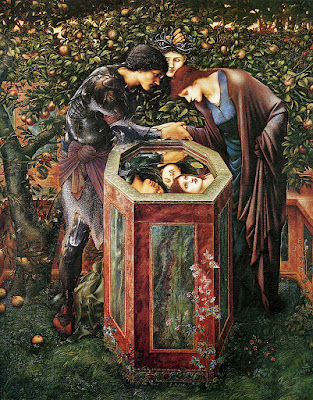
Madonna and Child: a painting by Filippo Lippi
NOTE: Like the previous poems, this one has some historical detail and references that might initially be confusing. However, once you get past them, it's an easier read than those poems, and you get more time to 'live' with the character. And Fra Lippo Lippi is Browning's greatest character, an almost Shakespearean character who seems to live and breathe, and has a very unique view of the world. Here are some notes to help you delve into the poem:
THE STORY: Basically, Fra Lippo Lippi is a monk and a painter who works for Cosimo dei Medici, of the famous banking family that ruled Florence. He is holed up in Cosimo's house to create a number of religious paintings for him. But he gets sick of painting and hears the carnival going on outside, so ties up his bedsheets as a ladder and sneaks off into the night to party with the 'women of the night.' He is caught by the night guards and interrogated, until he can prove who is he and who he works for. Then he tells the story of his life and his philosophy as an artist. The painting that he describes at the end of the painting is a real painting, The Coronation of the Virgin, which I'll show you in class.
Fra Lippo Lippi: actually, Filippo Lippi, a famous Florentine painter who lived from 1406 to 1469. He was a monk, though the episode in the poem is made up by Browning to give drama (and humor) to the piece.
Zooks: a mild curse, basically "gadzooks"--it originally meant "God's wounds," but was mangled into "zounds" and then "zooks."
Weke, weke: imitating the cry of a mouse
Flower o' the broom, etc.: These are famous folk and street songs that Fra Lippo Lippi sings throughout the poem to comment on his situation. He's probably more than a little drunk, so he keeps interrupting himself with his singing.
The Eight: the magistrates (judges) of Florence
antiphonary: a book of choral songs
phiz: face
They want a cast o' my office: they want a sample of my work
iste perfecit opus: "he made the work"
kirtles: skirts
hot cockles: a game that had to be played with three or more people, where one person is blindfolded, and has to guess who is striking or pinching them. So the joke is that Fra Lippo Lippi is playing this with more than one partner!
QUESTIONS: Answer TWO of the following...
Q1: Fra Lippo Lippi is another religious figure with questionable morals and a very loose interpretation of his religious calling. How does he compare to the Monk-Narrator in Soliloquy of the Spanish Cloister or The Bishop? Is he another satire of religious hypocrisy? Or does Browning want us to like him a bit more?
Q2: According to the painter, how did hunger and poverty make him a great painter? What is it that he can see that other painters can't--and that his superior often miss themselves? How does this lead to his great breakthrough as an artist?
Q3: When the Prior (head monk) first views Fra Lippo Lippi's work, he thunders his disapproval by saying, "Your business is not to catch men with show,/With homage to the perishable clay,/But life them over it, ignore it all,/Make them forget there's such a thing as flesh." Why was the church against realism or even the depiction of emotion in art? What did they feel it 'took away' from the experience of the painting?
Q4: Toward the end of the poem, Fra Lippo Lippi argues that "What would men have? Do they like grass or no--/May they or mayn't they? all I want's the thing/Settled for ever one way. As it is,/You tell too many lies and hurt yourself:/You don't like what you like only too much,/You do like what, if given you at your word,/You find abundantly detestable." What's he talking about here? What "lies" are they telling themselves, and why can't men simply "like grass"?
Q5: One more tricky passage: what do you think he means when he claims, "This word's no blot for us,/Nor blank; it means intensely, and means good"? Why might this be the underlying philosophy of Lippi's life?









